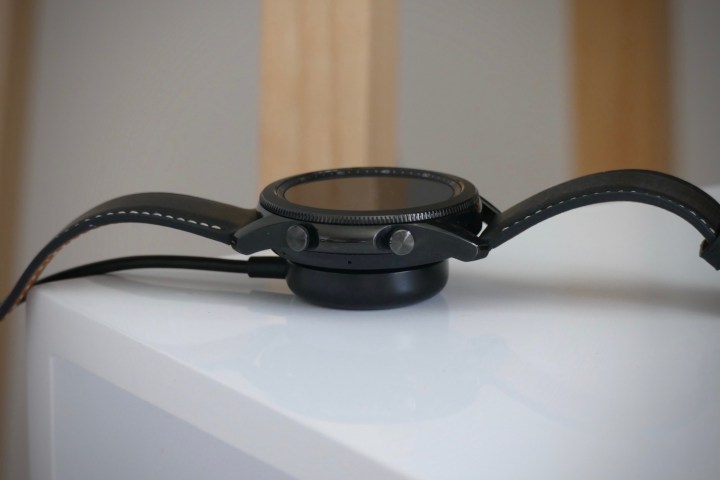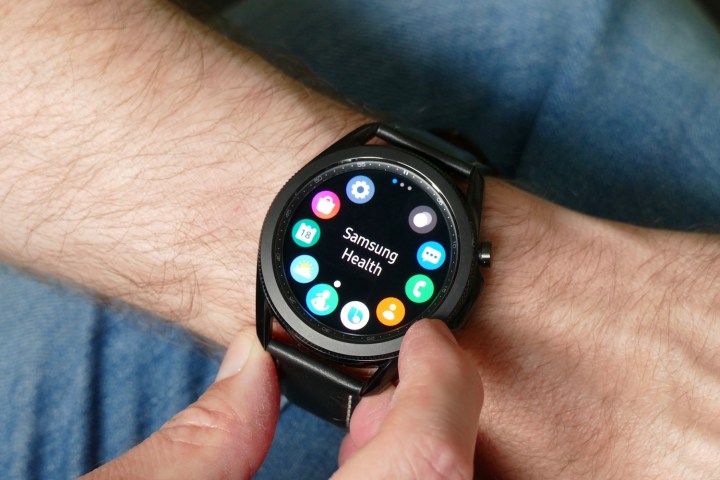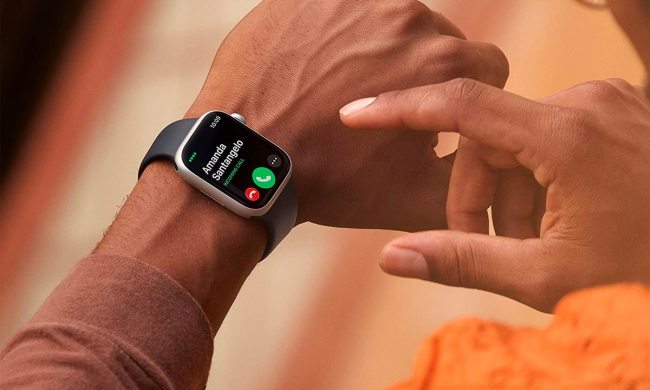The Apple Watch Series 6 is here, and it shows Apple is taking an even greater focus on personal health with their best smartwatch. It introduces a new blood oxygen level sensor that can measure your O2 levels even while you sleep, as well as an always-on altimeter for the hikers among us. Combined with a brighter always-on display and quirky new watch faces, it goes one step further than the Series 5 in offering a comprehensive health-and-fitness tracker that doubles as a very usable smartwatch.
It’s not the only new smartwatch in town, however. Samsung released its Galaxy Watch 3 in August, and it’s every bit as good as you’d expect a smartwatch from Samsung to be. It takes a more classical watch approach to its design, while adding a nifty rotating bezel that makes using its features as effortless as possible.
It’s a great smartwatch, and so too is the Apple Watch Series 6. The question is: Which one is better? We compare the two watches to find out, looking at how they measure up in terms of their designs, displays, health features, batteries, and special features. This should give you a good idea of which smartwatch best suits you.
Specs
| Apple Watch Series 6 |
Samsung Galaxy Watch 3 | |
| Display size | 40 mm: 1.57 inches
44 mm: 1.78 inches |
41 mm: 1.2 inches
45 mm: 1.4 inches |
| Body size | 40 mm: 40 x 34 x 10.7mm (1.57 x 1.34 x 0.41 inches)
44 mm: 44 x 38 x 10.7mm (1.73 x 1.50 x 0.41 inches) |
41 mm: 42.5 x 41 x 11.3 mm (1.67 x 1.61 x 0.44 inches)
45 mm: 46.2 x 45 x 11.1 mm (1.82 x 1.77 x 0.44 inches) |
| Resolution | 40 mm: 324 x 394 pixels (326 pixels per inch)
44 mm: 368 x 448 pixels (326 pixels per inch) |
41 mm: 360 x 360 pixels (364 pixels per inch)
45 mm: 360 x 360 pixels (364 pixels per inch) |
| Touchscreen |
40 mm: 1.57-inch LTPO OLED Retina display w/ Force Touch 44 mm: 1.78-inch LTPO OLED Retina display w/ Force Touch
|
41 mm: 1.2-inch Super AMOLED capacitive touchscreen
45 mm: 1.4-inch Super AMOLED capacitive touchscreen |
| Storage | 32GB | 8GB |
| Wireless interface | Bluetooth 5.0, Wi-Fi 802.11 b/g/n, NFC, LTE | Bluetooth 5.0, Wi-Fi 802.11 b/g/n, NFC, LTE |
| Depth | 10.7 mm | 41 mm: 11.3 mm
45 mm: 11.1 mm |
| Blood Oxygen Sensor |
Yes | Yes |
| Accelerometer | Yes | Yes |
| Gyroscope | Yes | Yes |
| Ambient light sensor | Yes | Yes |
| Heart rate sensor | Yes | Yes |
| Barometer | Yes | Yes |
| GPS | Yes | Yes |
| Compass | Yes | No |
| Water-resistant | Yes | Yes |
| Battery life | Up to 18 hours | Up to 120 hours (low usage) |
| Price | From $400 | From $400 |
| Availability | Apple | Samsung |
| DT review | 4.5 stars out of 5 | 4 out of 5 stars |
Design and display

You may be unsurprised to hear the Apple Watch Series 6 doesn’t really depart from the design of the Apple Watch Series 5. It retains the distinctive “squircle” shape, encased in a choice of either stainless steel, aluminum, or titanium, all of which look suitably sleek and refined. This time, however, Apple has extended the range of colors and bands on offer, adding a new blue color to the range available with aluminum cases, while also adding graphite and yellow gold to its stainless steel selection. It has also added a limited edition (PRODUCT)RED version, as seen on many of its smartphones.
It looks gorgeous, but then so does the Samsung Galaxy Watch 3 — albeit in different ways. While the Apple Watch Series 6 has something space-age and ultra-modern about it, the Galaxy Watch 3 goes for a more traditional design. It apes the look of a normal watch, coming in a circle case and providing an always-on display that mimics an analog watch face. Outside observers won’t suspect you’re wearing a smartwatch, and this may appeal to anyone with more inconspicuous tastes.
The displays of both smartwatches are also very sharp. The Apple Watch Series 6 offers a resolution of either 324 x 394 pixels or 368 x 448 pixels, depending on whether you opt for the 40mm or 44mm version. Either way, you’ll be getting 326 pixels per inch, which actually falls short of the Galaxy Watch 3’s 364 pixels per inch. This makes Samsung’s watch a little crisper, although either version of the Apple Watch Series 6 comes with a larger display than either version (41mm or 45mm) of the Galaxy Watch 3, so anyone who prefers larger screens may be happier with Apple’s device.
Given that the watches cater to different tastes in terms of their designs and displays, we’re going to call this round a tie.
Winner: Tie
Fitness and health-tracking features

Make no mistake, Apple is pushing health-and-fitness tracking one step further with the Watch Series 6. The Apple Watch Series 5 already had an impressively comprehensive range of fitness and health features, but the Series 6 manages to add a few more helpful functions into the mix. Most notably, it adds an infrared sensor that monitors your blood’s oxygen saturation (also known as SpO2). This tells you how much oxygen your blood is carrying, with levels below 95% potentially indicating an underlying health issue (always consult a physician before jumping to any conclusions, of course). That said, this kind of pulse oximetry is useful only if you suffer from certain medical conditions, in which case you’d actually be safer using a medical-grade blood-oxygen monitor instead.
Another new feature is an always-on altimeter, which combines the Apple Watch Series 6’s barometer, GPS, and Wi-Fi to provide you with an accurate measurement of your elevation. It’s not an earth-shattering addition, but anyone who hikes regularly will appreciate being able to glance at their altitude without having to wake up the watch.
As for the Samsung Galaxy Watch 3, it also offers a satisfyingly wide range of health and fitness features. It packs a heart rate monitor, sleep tracking, automatic fall detection, and VO2 max data. It also allows for blood oxygen level monitoring just like the Apple Watch Series 6, although it doesn’t have a compass.
Unfortunately, while the Galaxy Watch 3 offers a nice variety of features, our Galaxy Watch 3 review found some issues with the accuracy of its tracking software. The data it provides does have a tendency to deviate from the data provided by other, more proven monitors (such as the Withings Sleep Analyzer). This may be a big turnoff for anyone who wants to make sure they receive the most accurate health and fitness data possible.
Because of this failing on the part of Samsung’s watch, we’re giving this round to the Apple Watch Series 6.
Winner: Apple Watch Series 6
Battery life

The Apple Watch Series 6 offers the same 18 hours of battery life as its predecessors. This may be disappointing for some, but given that it adds a new processor that’s reportedly 20% faster and also provides a brighter always-on display, we guess it’s an achievement that it can still maintain a running time of 18 hours without needing a recharge.
Turning to the Galaxy Watch 3, Samsung’s official spec sheet makes some very interesting claims. It says that “typical” usage time for the watch is 43 hours, and that it can last for a whopping 120 hours under low usage. Our experience was fairly different, however, with the Galaxy Watch 3’s battery depleting faster than the Apple Watch Series 5’s over the course of a couple of days. We found in our review of the Apple Watch Series 6 that it also lasts two days, assuming that you switch it off overnight or don’t use GSP and fitness-tracking very frequently.
The Samsung Galaxy Watch 3 also had the unfortunate problem of charging relatively slowly. Added to the slightly less impressive battery life, this round is another win for Apple’s device.
Winner: Apple Watch Series 6
Special features

Aside from the blood oxygen level monitor and always-on altimeter, the Apple Watch Series 6 introduces the new S6 SiP processor, which does largely live up to Apple’s claims that it will help the watch run 20% than its predecessor. It also adds the new U1 chip and Ultra Wideband antennas, which are designed to enable new functions based around the use of short-range wireless location signaling, such as digital car keys.
While it will also be available for older Apple smartwatches, the new WatchOS 7 introduces Family Setup. This is a new feature that lets connected devices (e.g. the iPhones of family members) benefit from the connectivity, safety, and fitness features of the Apple Watch Series 6. This includes the ability for children to use the feature to send Emergency SOS calls, for example.
The Samsung Galaxy Watch 3’s special feature is its rotating bezel. You can turn this to scroll through and select apps, saving you the hassle of tapping the watch and blocking your view of the display as you do so. It also prevents you from smearing the watch’s display via your own greasy fingerprints, something which may ultimately extend the life of the Galaxy Watch 3.
This round is a close one, but because a rotating bezel is a fairly unique feature, we’re going to give the win to the Samsung Galaxy Watch 3.
Winner: Samsung Galaxy Watch 3
Price and availability
The Apple Watch Series 6 is available on September 18 and starts at $399 for the GPS aluminum model. Other models incorporating different case materials or LTE connectivity will cost more, with the titanium models starting at $849.
The Samsung Galaxy Watch 3 is available now and also starts from $399. Again, it will cost more if you want to have 4G LTE, which adds $50, or if you want the 45mm model instead of the 41mm.
Take a look at some of the best Apple Watch deals and smartwatch deals going on right now ahead of Cyber Monday sales.
Overall winner: Apple Watch Series 6

It’s a fairly close-run contest, but the Apple Watch Series 6 is definitely a better smartwatch than the Samsung Galaxy Watch 3. The two watches are attractive in their own respective ways, but Apple’s device boasts more reliable health-and-fitness tracking, and it offers a slightly longer-lasting battery. If you want a smartwatch mostly for health-related reasons, it’s certainly the first choice, and is priced at the same level as the Galaxy Watch 3 despite being newer.
The Galaxy Watch 3 comes a very close second. We can easily imagine it appealing more to people who aren’t looking specifically for a fitness-oriented watch, particularly when taking into account its elegant design and vivid display — or for those using an Android smartphone, as the Apple Watch only works with iPhones. So while the Galaxy Watch 3 is a very good smartwatch, the Apple Watch Series 6 is the winner, thanks to its exhaustive new features and fast new processor.



